Project Management on Titanic Ship: Case Study and Analysis Report
VerifiedAdded on 2020/01/28
|17
|5917
|1288
Report
AI Summary
This report offers a comprehensive analysis of the project management aspects of the Titanic ship. It begins with an introduction to project management, defining its core principles and significance, and then uses the Titanic as a case study to illustrate these concepts. The report delves into the project's background, including its objectives, scope, and business case, highlighting the motivations behind the ship's construction. It examines the various phases of the project, from initiation and planning to design, construction, testing, and implementation, detailing the key constraints, assumptions, and milestones involved. The report also explores critical elements like time and cost management, risk analysis, and the roles of different stakeholders. Finally, it discusses the methodologies and processes employed to ensure the project's success and concludes with an assessment of the project's overall management, drawing lessons from the historical context of the Titanic's construction and tragic fate.
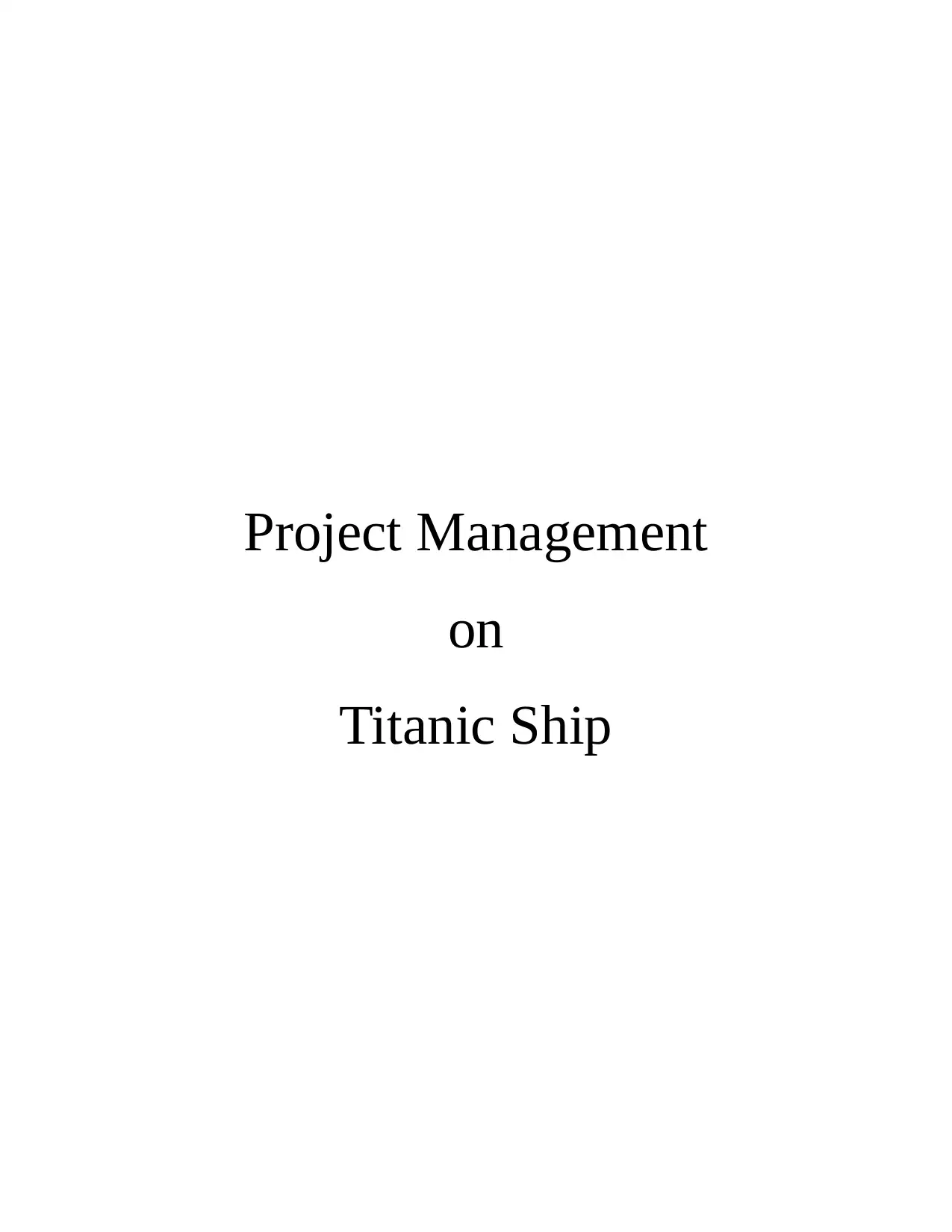
Project Management
on
Titanic Ship
on
Titanic Ship
Paraphrase This Document
Need a fresh take? Get an instant paraphrase of this document with our AI Paraphraser
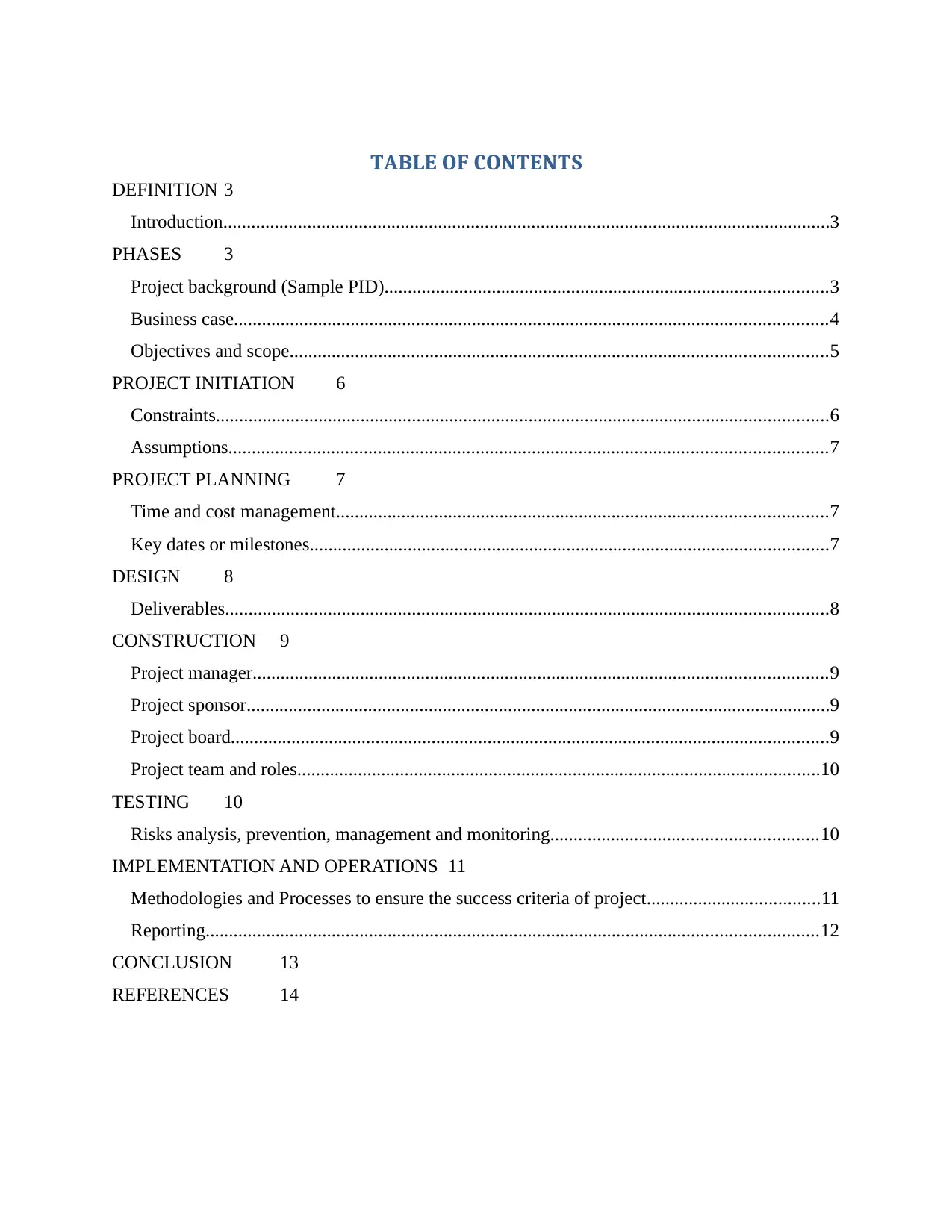
TABLE OF CONTENTS
DEFINITION 3
Introduction..................................................................................................................................3
PHASES 3
Project background (Sample PID)...............................................................................................3
Business case...............................................................................................................................4
Objectives and scope...................................................................................................................5
PROJECT INITIATION 6
Constraints...................................................................................................................................6
Assumptions................................................................................................................................7
PROJECT PLANNING 7
Time and cost management.........................................................................................................7
Key dates or milestones...............................................................................................................7
DESIGN 8
Deliverables.................................................................................................................................8
CONSTRUCTION 9
Project manager...........................................................................................................................9
Project sponsor.............................................................................................................................9
Project board................................................................................................................................9
Project team and roles................................................................................................................10
TESTING 10
Risks analysis, prevention, management and monitoring.........................................................10
IMPLEMENTATION AND OPERATIONS 11
Methodologies and Processes to ensure the success criteria of project.....................................11
Reporting...................................................................................................................................12
CONCLUSION 13
REFERENCES 14
DEFINITION 3
Introduction..................................................................................................................................3
PHASES 3
Project background (Sample PID)...............................................................................................3
Business case...............................................................................................................................4
Objectives and scope...................................................................................................................5
PROJECT INITIATION 6
Constraints...................................................................................................................................6
Assumptions................................................................................................................................7
PROJECT PLANNING 7
Time and cost management.........................................................................................................7
Key dates or milestones...............................................................................................................7
DESIGN 8
Deliverables.................................................................................................................................8
CONSTRUCTION 9
Project manager...........................................................................................................................9
Project sponsor.............................................................................................................................9
Project board................................................................................................................................9
Project team and roles................................................................................................................10
TESTING 10
Risks analysis, prevention, management and monitoring.........................................................10
IMPLEMENTATION AND OPERATIONS 11
Methodologies and Processes to ensure the success criteria of project.....................................11
Reporting...................................................................................................................................12
CONCLUSION 13
REFERENCES 14
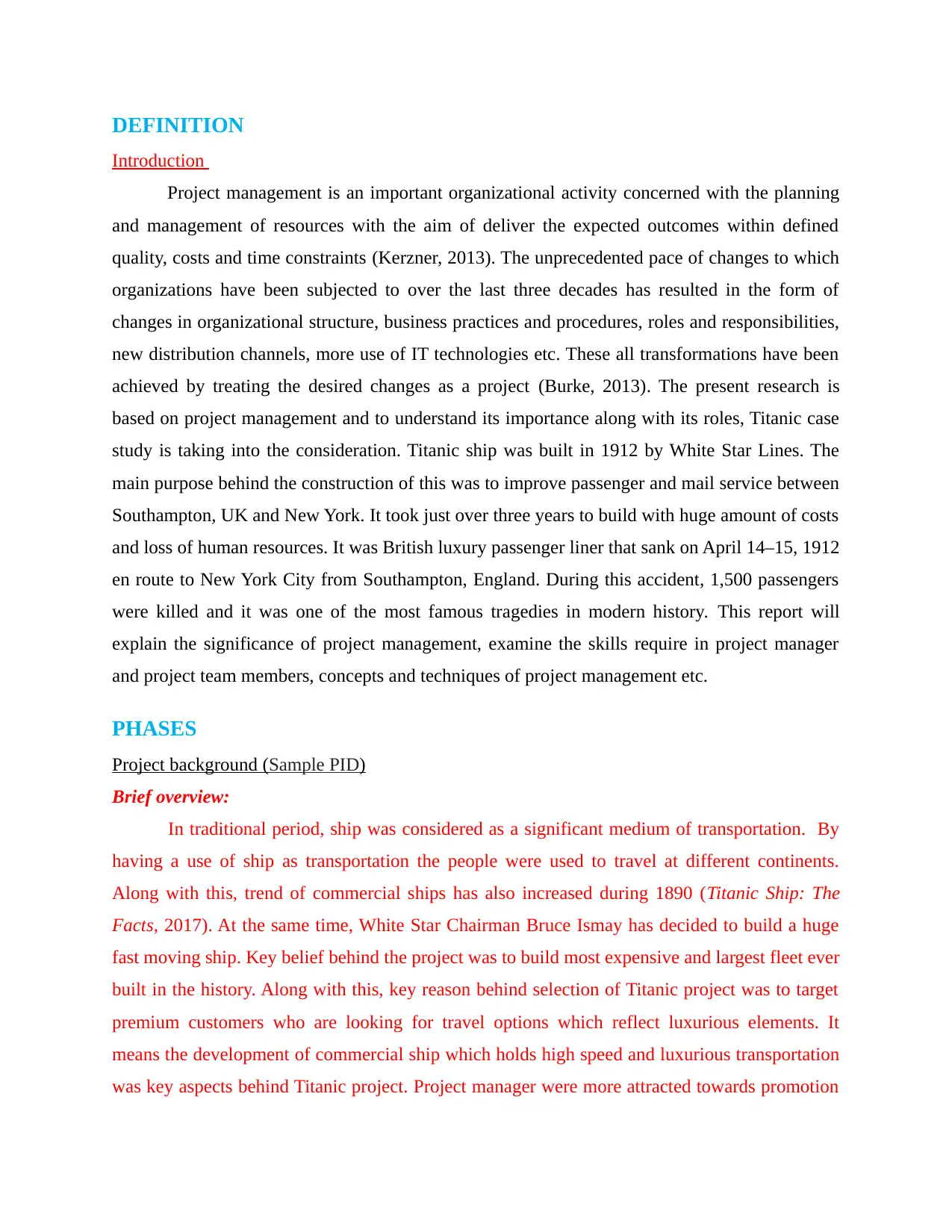
DEFINITION
Introduction
Project management is an important organizational activity concerned with the planning
and management of resources with the aim of deliver the expected outcomes within defined
quality, costs and time constraints (Kerzner, 2013). The unprecedented pace of changes to which
organizations have been subjected to over the last three decades has resulted in the form of
changes in organizational structure, business practices and procedures, roles and responsibilities,
new distribution channels, more use of IT technologies etc. These all transformations have been
achieved by treating the desired changes as a project (Burke, 2013). The present research is
based on project management and to understand its importance along with its roles, Titanic case
study is taking into the consideration. Titanic ship was built in 1912 by White Star Lines. The
main purpose behind the construction of this was to improve passenger and mail service between
Southampton, UK and New York. It took just over three years to build with huge amount of costs
and loss of human resources. It was British luxury passenger liner that sank on April 14–15, 1912
en route to New York City from Southampton, England. During this accident, 1,500 passengers
were killed and it was one of the most famous tragedies in modern history. This report will
explain the significance of project management, examine the skills require in project manager
and project team members, concepts and techniques of project management etc.
PHASES
Project background (Sample PID)
Brief overview:
In traditional period, ship was considered as a significant medium of transportation. By
having a use of ship as transportation the people were used to travel at different continents.
Along with this, trend of commercial ships has also increased during 1890 (Titanic Ship: The
Facts, 2017). At the same time, White Star Chairman Bruce Ismay has decided to build a huge
fast moving ship. Key belief behind the project was to build most expensive and largest fleet ever
built in the history. Along with this, key reason behind selection of Titanic project was to target
premium customers who are looking for travel options which reflect luxurious elements. It
means the development of commercial ship which holds high speed and luxurious transportation
was key aspects behind Titanic project. Project manager were more attracted towards promotion
Introduction
Project management is an important organizational activity concerned with the planning
and management of resources with the aim of deliver the expected outcomes within defined
quality, costs and time constraints (Kerzner, 2013). The unprecedented pace of changes to which
organizations have been subjected to over the last three decades has resulted in the form of
changes in organizational structure, business practices and procedures, roles and responsibilities,
new distribution channels, more use of IT technologies etc. These all transformations have been
achieved by treating the desired changes as a project (Burke, 2013). The present research is
based on project management and to understand its importance along with its roles, Titanic case
study is taking into the consideration. Titanic ship was built in 1912 by White Star Lines. The
main purpose behind the construction of this was to improve passenger and mail service between
Southampton, UK and New York. It took just over three years to build with huge amount of costs
and loss of human resources. It was British luxury passenger liner that sank on April 14–15, 1912
en route to New York City from Southampton, England. During this accident, 1,500 passengers
were killed and it was one of the most famous tragedies in modern history. This report will
explain the significance of project management, examine the skills require in project manager
and project team members, concepts and techniques of project management etc.
PHASES
Project background (Sample PID)
Brief overview:
In traditional period, ship was considered as a significant medium of transportation. By
having a use of ship as transportation the people were used to travel at different continents.
Along with this, trend of commercial ships has also increased during 1890 (Titanic Ship: The
Facts, 2017). At the same time, White Star Chairman Bruce Ismay has decided to build a huge
fast moving ship. Key belief behind the project was to build most expensive and largest fleet ever
built in the history. Along with this, key reason behind selection of Titanic project was to target
premium customers who are looking for travel options which reflect luxurious elements. It
means the development of commercial ship which holds high speed and luxurious transportation
was key aspects behind Titanic project. Project manager were more attracted towards promotion
⊘ This is a preview!⊘
Do you want full access?
Subscribe today to unlock all pages.

Trusted by 1+ million students worldwide
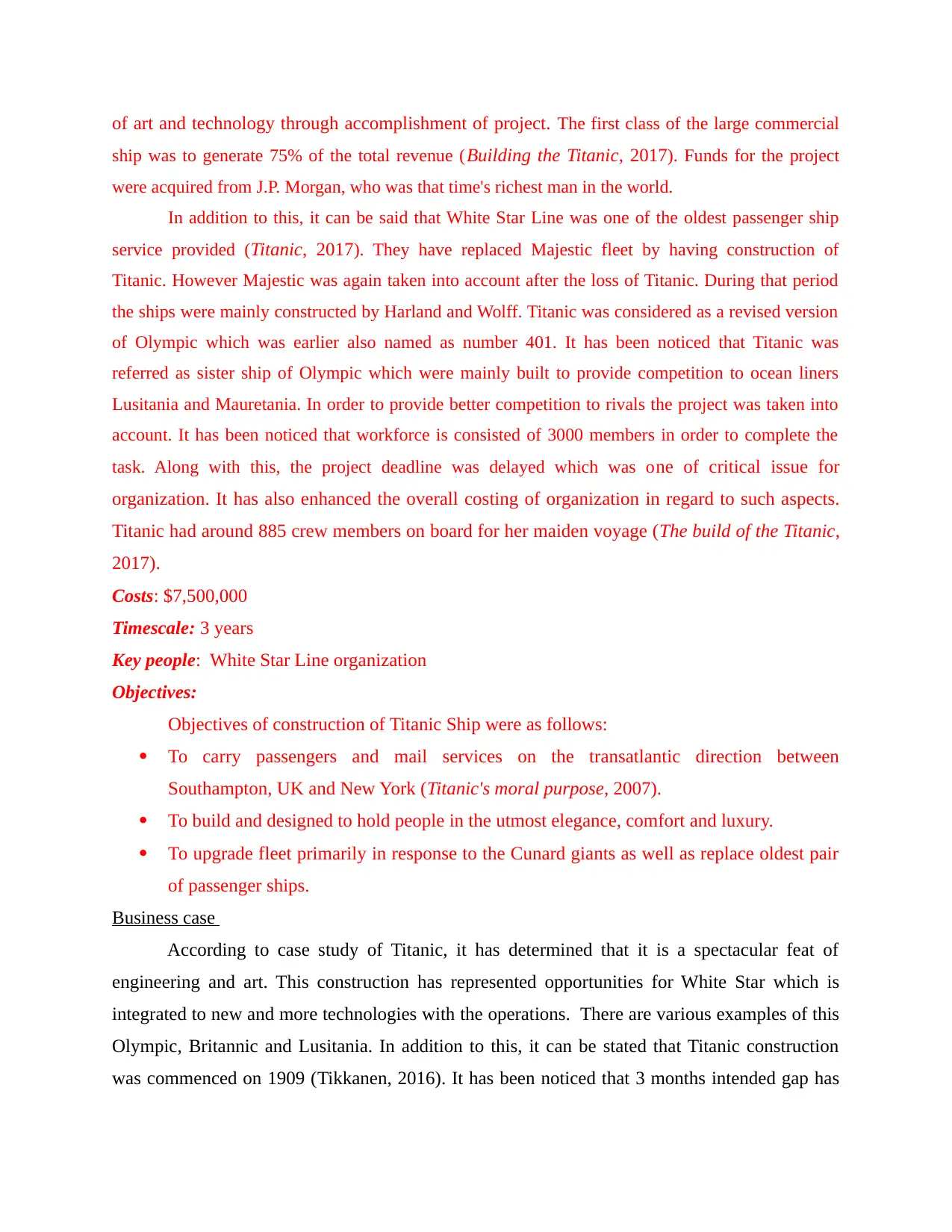
of art and technology through accomplishment of project. The first class of the large commercial
ship was to generate 75% of the total revenue (Building the Titanic, 2017). Funds for the project
were acquired from J.P. Morgan, who was that time's richest man in the world.
In addition to this, it can be said that White Star Line was one of the oldest passenger ship
service provided (Titanic, 2017). They have replaced Majestic fleet by having construction of
Titanic. However Majestic was again taken into account after the loss of Titanic. During that period
the ships were mainly constructed by Harland and Wolff. Titanic was considered as a revised version
of Olympic which was earlier also named as number 401. It has been noticed that Titanic was
referred as sister ship of Olympic which were mainly built to provide competition to ocean liners
Lusitania and Mauretania. In order to provide better competition to rivals the project was taken into
account. It has been noticed that workforce is consisted of 3000 members in order to complete the
task. Along with this, the project deadline was delayed which was one of critical issue for
organization. It has also enhanced the overall costing of organization in regard to such aspects.
Titanic had around 885 crew members on board for her maiden voyage (The build of the Titanic,
2017).
Costs: $7,500,000
Timescale: 3 years
Key people: White Star Line organization
Objectives:
Objectives of construction of Titanic Ship were as follows:
To carry passengers and mail services on the transatlantic direction between
Southampton, UK and New York (Titanic's moral purpose, 2007).
To build and designed to hold people in the utmost elegance, comfort and luxury.
To upgrade fleet primarily in response to the Cunard giants as well as replace oldest pair
of passenger ships.
Business case
According to case study of Titanic, it has determined that it is a spectacular feat of
engineering and art. This construction has represented opportunities for White Star which is
integrated to new and more technologies with the operations. There are various examples of this
Olympic, Britannic and Lusitania. In addition to this, it can be stated that Titanic construction
was commenced on 1909 (Tikkanen, 2016). It has been noticed that 3 months intended gap has
ship was to generate 75% of the total revenue (Building the Titanic, 2017). Funds for the project
were acquired from J.P. Morgan, who was that time's richest man in the world.
In addition to this, it can be said that White Star Line was one of the oldest passenger ship
service provided (Titanic, 2017). They have replaced Majestic fleet by having construction of
Titanic. However Majestic was again taken into account after the loss of Titanic. During that period
the ships were mainly constructed by Harland and Wolff. Titanic was considered as a revised version
of Olympic which was earlier also named as number 401. It has been noticed that Titanic was
referred as sister ship of Olympic which were mainly built to provide competition to ocean liners
Lusitania and Mauretania. In order to provide better competition to rivals the project was taken into
account. It has been noticed that workforce is consisted of 3000 members in order to complete the
task. Along with this, the project deadline was delayed which was one of critical issue for
organization. It has also enhanced the overall costing of organization in regard to such aspects.
Titanic had around 885 crew members on board for her maiden voyage (The build of the Titanic,
2017).
Costs: $7,500,000
Timescale: 3 years
Key people: White Star Line organization
Objectives:
Objectives of construction of Titanic Ship were as follows:
To carry passengers and mail services on the transatlantic direction between
Southampton, UK and New York (Titanic's moral purpose, 2007).
To build and designed to hold people in the utmost elegance, comfort and luxury.
To upgrade fleet primarily in response to the Cunard giants as well as replace oldest pair
of passenger ships.
Business case
According to case study of Titanic, it has determined that it is a spectacular feat of
engineering and art. This construction has represented opportunities for White Star which is
integrated to new and more technologies with the operations. There are various examples of this
Olympic, Britannic and Lusitania. In addition to this, it can be stated that Titanic construction
was commenced on 1909 (Tikkanen, 2016). It has been noticed that 3 months intended gap has
Paraphrase This Document
Need a fresh take? Get an instant paraphrase of this document with our AI Paraphraser
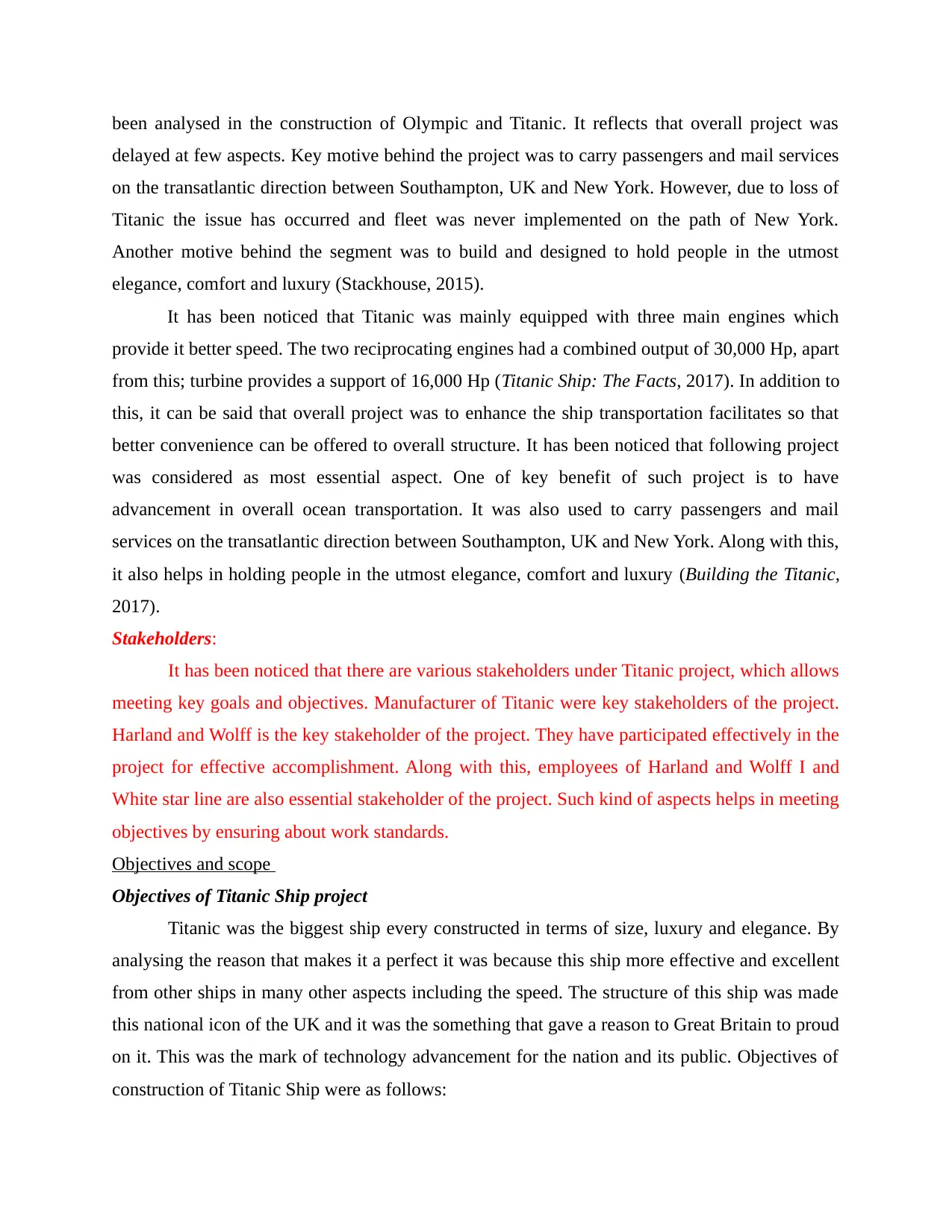
been analysed in the construction of Olympic and Titanic. It reflects that overall project was
delayed at few aspects. Key motive behind the project was to carry passengers and mail services
on the transatlantic direction between Southampton, UK and New York. However, due to loss of
Titanic the issue has occurred and fleet was never implemented on the path of New York.
Another motive behind the segment was to build and designed to hold people in the utmost
elegance, comfort and luxury (Stackhouse, 2015).
It has been noticed that Titanic was mainly equipped with three main engines which
provide it better speed. The two reciprocating engines had a combined output of 30,000 Hp, apart
from this; turbine provides a support of 16,000 Hp (Titanic Ship: The Facts, 2017). In addition to
this, it can be said that overall project was to enhance the ship transportation facilitates so that
better convenience can be offered to overall structure. It has been noticed that following project
was considered as most essential aspect. One of key benefit of such project is to have
advancement in overall ocean transportation. It was also used to carry passengers and mail
services on the transatlantic direction between Southampton, UK and New York. Along with this,
it also helps in holding people in the utmost elegance, comfort and luxury (Building the Titanic,
2017).
Stakeholders:
It has been noticed that there are various stakeholders under Titanic project, which allows
meeting key goals and objectives. Manufacturer of Titanic were key stakeholders of the project.
Harland and Wolff is the key stakeholder of the project. They have participated effectively in the
project for effective accomplishment. Along with this, employees of Harland and Wolff I and
White star line are also essential stakeholder of the project. Such kind of aspects helps in meeting
objectives by ensuring about work standards.
Objectives and scope
Objectives of Titanic Ship project
Titanic was the biggest ship every constructed in terms of size, luxury and elegance. By
analysing the reason that makes it a perfect it was because this ship more effective and excellent
from other ships in many other aspects including the speed. The structure of this ship was made
this national icon of the UK and it was the something that gave a reason to Great Britain to proud
on it. This was the mark of technology advancement for the nation and its public. Objectives of
construction of Titanic Ship were as follows:
delayed at few aspects. Key motive behind the project was to carry passengers and mail services
on the transatlantic direction between Southampton, UK and New York. However, due to loss of
Titanic the issue has occurred and fleet was never implemented on the path of New York.
Another motive behind the segment was to build and designed to hold people in the utmost
elegance, comfort and luxury (Stackhouse, 2015).
It has been noticed that Titanic was mainly equipped with three main engines which
provide it better speed. The two reciprocating engines had a combined output of 30,000 Hp, apart
from this; turbine provides a support of 16,000 Hp (Titanic Ship: The Facts, 2017). In addition to
this, it can be said that overall project was to enhance the ship transportation facilitates so that
better convenience can be offered to overall structure. It has been noticed that following project
was considered as most essential aspect. One of key benefit of such project is to have
advancement in overall ocean transportation. It was also used to carry passengers and mail
services on the transatlantic direction between Southampton, UK and New York. Along with this,
it also helps in holding people in the utmost elegance, comfort and luxury (Building the Titanic,
2017).
Stakeholders:
It has been noticed that there are various stakeholders under Titanic project, which allows
meeting key goals and objectives. Manufacturer of Titanic were key stakeholders of the project.
Harland and Wolff is the key stakeholder of the project. They have participated effectively in the
project for effective accomplishment. Along with this, employees of Harland and Wolff I and
White star line are also essential stakeholder of the project. Such kind of aspects helps in meeting
objectives by ensuring about work standards.
Objectives and scope
Objectives of Titanic Ship project
Titanic was the biggest ship every constructed in terms of size, luxury and elegance. By
analysing the reason that makes it a perfect it was because this ship more effective and excellent
from other ships in many other aspects including the speed. The structure of this ship was made
this national icon of the UK and it was the something that gave a reason to Great Britain to proud
on it. This was the mark of technology advancement for the nation and its public. Objectives of
construction of Titanic Ship were as follows:
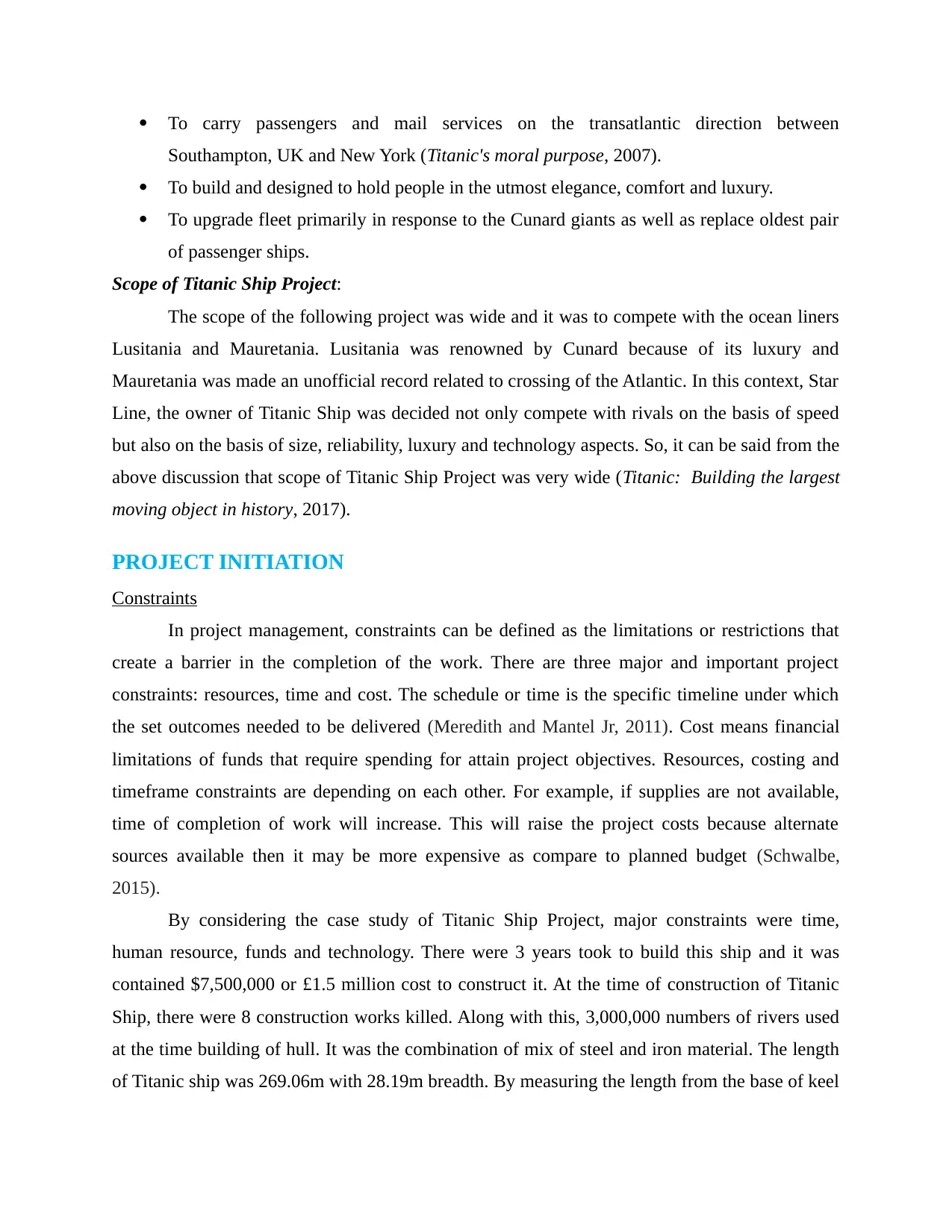
To carry passengers and mail services on the transatlantic direction between
Southampton, UK and New York (Titanic's moral purpose, 2007).
To build and designed to hold people in the utmost elegance, comfort and luxury.
To upgrade fleet primarily in response to the Cunard giants as well as replace oldest pair
of passenger ships.
Scope of Titanic Ship Project:
The scope of the following project was wide and it was to compete with the ocean liners
Lusitania and Mauretania. Lusitania was renowned by Cunard because of its luxury and
Mauretania was made an unofficial record related to crossing of the Atlantic. In this context, Star
Line, the owner of Titanic Ship was decided not only compete with rivals on the basis of speed
but also on the basis of size, reliability, luxury and technology aspects. So, it can be said from the
above discussion that scope of Titanic Ship Project was very wide (Titanic: Building the largest
moving object in history, 2017).
PROJECT INITIATION
Constraints
In project management, constraints can be defined as the limitations or restrictions that
create a barrier in the completion of the work. There are three major and important project
constraints: resources, time and cost. The schedule or time is the specific timeline under which
the set outcomes needed to be delivered (Meredith and Mantel Jr, 2011). Cost means financial
limitations of funds that require spending for attain project objectives. Resources, costing and
timeframe constraints are depending on each other. For example, if supplies are not available,
time of completion of work will increase. This will raise the project costs because alternate
sources available then it may be more expensive as compare to planned budget (Schwalbe,
2015).
By considering the case study of Titanic Ship Project, major constraints were time,
human resource, funds and technology. There were 3 years took to build this ship and it was
contained $7,500,000 or £1.5 million cost to construct it. At the time of construction of Titanic
Ship, there were 8 construction works killed. Along with this, 3,000,000 numbers of rivers used
at the time building of hull. It was the combination of mix of steel and iron material. The length
of Titanic ship was 269.06m with 28.19m breadth. By measuring the length from the base of keel
Southampton, UK and New York (Titanic's moral purpose, 2007).
To build and designed to hold people in the utmost elegance, comfort and luxury.
To upgrade fleet primarily in response to the Cunard giants as well as replace oldest pair
of passenger ships.
Scope of Titanic Ship Project:
The scope of the following project was wide and it was to compete with the ocean liners
Lusitania and Mauretania. Lusitania was renowned by Cunard because of its luxury and
Mauretania was made an unofficial record related to crossing of the Atlantic. In this context, Star
Line, the owner of Titanic Ship was decided not only compete with rivals on the basis of speed
but also on the basis of size, reliability, luxury and technology aspects. So, it can be said from the
above discussion that scope of Titanic Ship Project was very wide (Titanic: Building the largest
moving object in history, 2017).
PROJECT INITIATION
Constraints
In project management, constraints can be defined as the limitations or restrictions that
create a barrier in the completion of the work. There are three major and important project
constraints: resources, time and cost. The schedule or time is the specific timeline under which
the set outcomes needed to be delivered (Meredith and Mantel Jr, 2011). Cost means financial
limitations of funds that require spending for attain project objectives. Resources, costing and
timeframe constraints are depending on each other. For example, if supplies are not available,
time of completion of work will increase. This will raise the project costs because alternate
sources available then it may be more expensive as compare to planned budget (Schwalbe,
2015).
By considering the case study of Titanic Ship Project, major constraints were time,
human resource, funds and technology. There were 3 years took to build this ship and it was
contained $7,500,000 or £1.5 million cost to construct it. At the time of construction of Titanic
Ship, there were 8 construction works killed. Along with this, 3,000,000 numbers of rivers used
at the time building of hull. It was the combination of mix of steel and iron material. The length
of Titanic ship was 269.06m with 28.19m breadth. By measuring the length from the base of keel
⊘ This is a preview!⊘
Do you want full access?
Subscribe today to unlock all pages.

Trusted by 1+ million students worldwide
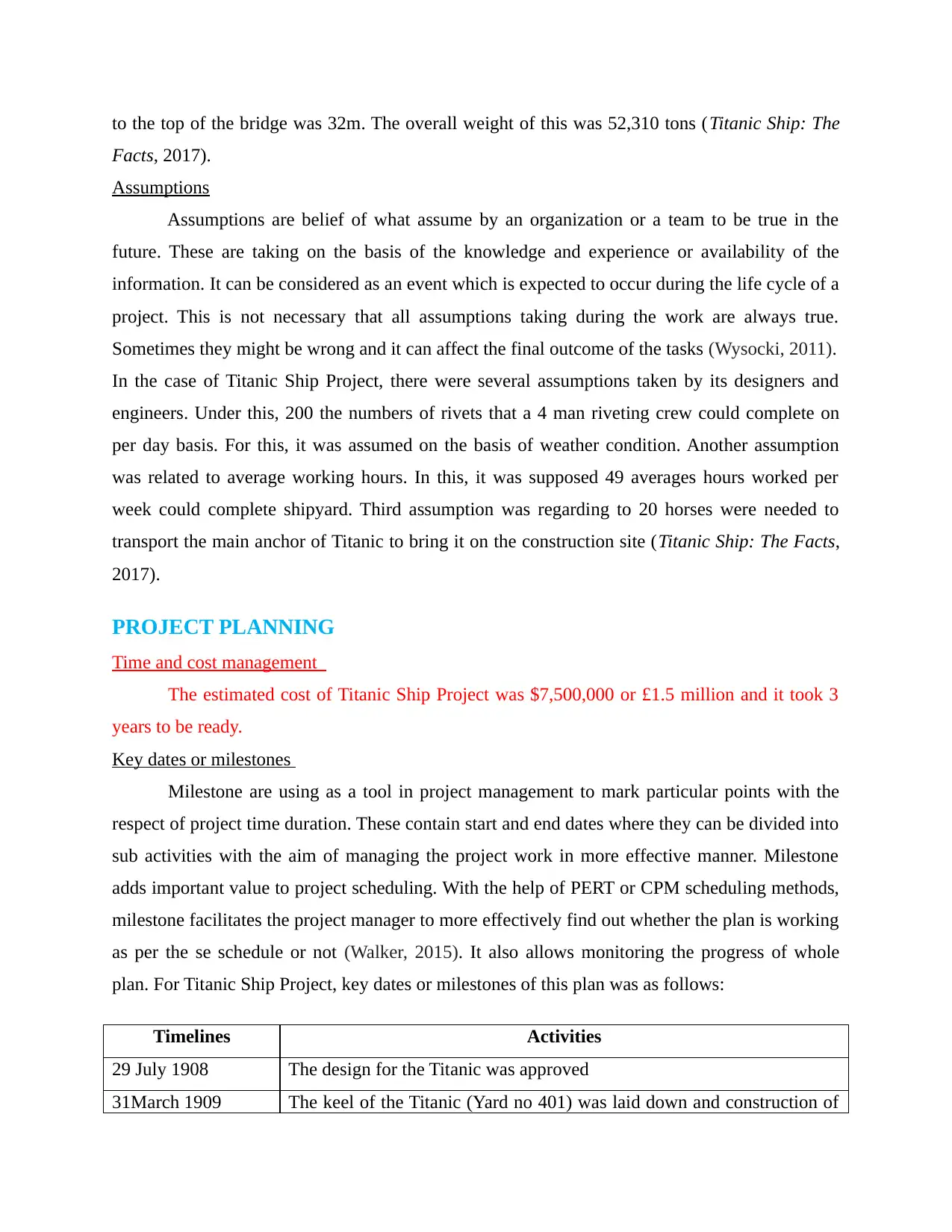
to the top of the bridge was 32m. The overall weight of this was 52,310 tons (Titanic Ship: The
Facts, 2017).
Assumptions
Assumptions are belief of what assume by an organization or a team to be true in the
future. These are taking on the basis of the knowledge and experience or availability of the
information. It can be considered as an event which is expected to occur during the life cycle of a
project. This is not necessary that all assumptions taking during the work are always true.
Sometimes they might be wrong and it can affect the final outcome of the tasks (Wysocki, 2011).
In the case of Titanic Ship Project, there were several assumptions taken by its designers and
engineers. Under this, 200 the numbers of rivets that a 4 man riveting crew could complete on
per day basis. For this, it was assumed on the basis of weather condition. Another assumption
was related to average working hours. In this, it was supposed 49 averages hours worked per
week could complete shipyard. Third assumption was regarding to 20 horses were needed to
transport the main anchor of Titanic to bring it on the construction site (Titanic Ship: The Facts,
2017).
PROJECT PLANNING
Time and cost management
The estimated cost of Titanic Ship Project was $7,500,000 or £1.5 million and it took 3
years to be ready.
Key dates or milestones
Milestone are using as a tool in project management to mark particular points with the
respect of project time duration. These contain start and end dates where they can be divided into
sub activities with the aim of managing the project work in more effective manner. Milestone
adds important value to project scheduling. With the help of PERT or CPM scheduling methods,
milestone facilitates the project manager to more effectively find out whether the plan is working
as per the se schedule or not (Walker, 2015). It also allows monitoring the progress of whole
plan. For Titanic Ship Project, key dates or milestones of this plan was as follows:
Timelines Activities
29 July 1908 The design for the Titanic was approved
31March 1909 The keel of the Titanic (Yard no 401) was laid down and construction of
Facts, 2017).
Assumptions
Assumptions are belief of what assume by an organization or a team to be true in the
future. These are taking on the basis of the knowledge and experience or availability of the
information. It can be considered as an event which is expected to occur during the life cycle of a
project. This is not necessary that all assumptions taking during the work are always true.
Sometimes they might be wrong and it can affect the final outcome of the tasks (Wysocki, 2011).
In the case of Titanic Ship Project, there were several assumptions taken by its designers and
engineers. Under this, 200 the numbers of rivets that a 4 man riveting crew could complete on
per day basis. For this, it was assumed on the basis of weather condition. Another assumption
was related to average working hours. In this, it was supposed 49 averages hours worked per
week could complete shipyard. Third assumption was regarding to 20 horses were needed to
transport the main anchor of Titanic to bring it on the construction site (Titanic Ship: The Facts,
2017).
PROJECT PLANNING
Time and cost management
The estimated cost of Titanic Ship Project was $7,500,000 or £1.5 million and it took 3
years to be ready.
Key dates or milestones
Milestone are using as a tool in project management to mark particular points with the
respect of project time duration. These contain start and end dates where they can be divided into
sub activities with the aim of managing the project work in more effective manner. Milestone
adds important value to project scheduling. With the help of PERT or CPM scheduling methods,
milestone facilitates the project manager to more effectively find out whether the plan is working
as per the se schedule or not (Walker, 2015). It also allows monitoring the progress of whole
plan. For Titanic Ship Project, key dates or milestones of this plan was as follows:
Timelines Activities
29 July 1908 The design for the Titanic was approved
31March 1909 The keel of the Titanic (Yard no 401) was laid down and construction of
Paraphrase This Document
Need a fresh take? Get an instant paraphrase of this document with our AI Paraphraser
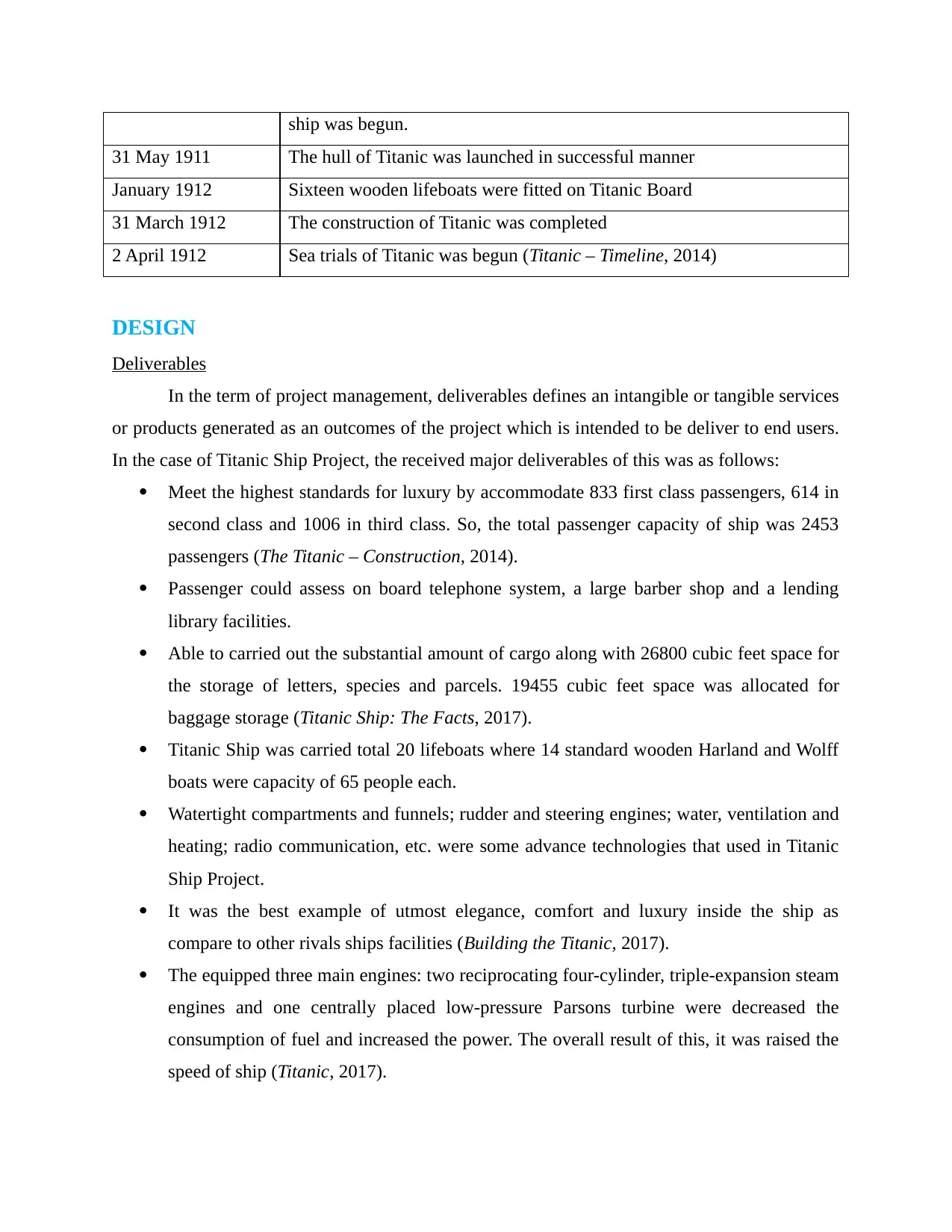
ship was begun.
31 May 1911 The hull of Titanic was launched in successful manner
January 1912 Sixteen wooden lifeboats were fitted on Titanic Board
31 March 1912 The construction of Titanic was completed
2 April 1912 Sea trials of Titanic was begun (Titanic – Timeline, 2014)
DESIGN
Deliverables
In the term of project management, deliverables defines an intangible or tangible services
or products generated as an outcomes of the project which is intended to be deliver to end users.
In the case of Titanic Ship Project, the received major deliverables of this was as follows:
Meet the highest standards for luxury by accommodate 833 first class passengers, 614 in
second class and 1006 in third class. So, the total passenger capacity of ship was 2453
passengers (The Titanic – Construction, 2014).
Passenger could assess on board telephone system, a large barber shop and a lending
library facilities.
Able to carried out the substantial amount of cargo along with 26800 cubic feet space for
the storage of letters, species and parcels. 19455 cubic feet space was allocated for
baggage storage (Titanic Ship: The Facts, 2017).
Titanic Ship was carried total 20 lifeboats where 14 standard wooden Harland and Wolff
boats were capacity of 65 people each.
Watertight compartments and funnels; rudder and steering engines; water, ventilation and
heating; radio communication, etc. were some advance technologies that used in Titanic
Ship Project.
It was the best example of utmost elegance, comfort and luxury inside the ship as
compare to other rivals ships facilities (Building the Titanic, 2017).
The equipped three main engines: two reciprocating four-cylinder, triple-expansion steam
engines and one centrally placed low-pressure Parsons turbine were decreased the
consumption of fuel and increased the power. The overall result of this, it was raised the
speed of ship (Titanic, 2017).
31 May 1911 The hull of Titanic was launched in successful manner
January 1912 Sixteen wooden lifeboats were fitted on Titanic Board
31 March 1912 The construction of Titanic was completed
2 April 1912 Sea trials of Titanic was begun (Titanic – Timeline, 2014)
DESIGN
Deliverables
In the term of project management, deliverables defines an intangible or tangible services
or products generated as an outcomes of the project which is intended to be deliver to end users.
In the case of Titanic Ship Project, the received major deliverables of this was as follows:
Meet the highest standards for luxury by accommodate 833 first class passengers, 614 in
second class and 1006 in third class. So, the total passenger capacity of ship was 2453
passengers (The Titanic – Construction, 2014).
Passenger could assess on board telephone system, a large barber shop and a lending
library facilities.
Able to carried out the substantial amount of cargo along with 26800 cubic feet space for
the storage of letters, species and parcels. 19455 cubic feet space was allocated for
baggage storage (Titanic Ship: The Facts, 2017).
Titanic Ship was carried total 20 lifeboats where 14 standard wooden Harland and Wolff
boats were capacity of 65 people each.
Watertight compartments and funnels; rudder and steering engines; water, ventilation and
heating; radio communication, etc. were some advance technologies that used in Titanic
Ship Project.
It was the best example of utmost elegance, comfort and luxury inside the ship as
compare to other rivals ships facilities (Building the Titanic, 2017).
The equipped three main engines: two reciprocating four-cylinder, triple-expansion steam
engines and one centrally placed low-pressure Parsons turbine were decreased the
consumption of fuel and increased the power. The overall result of this, it was raised the
speed of ship (Titanic, 2017).
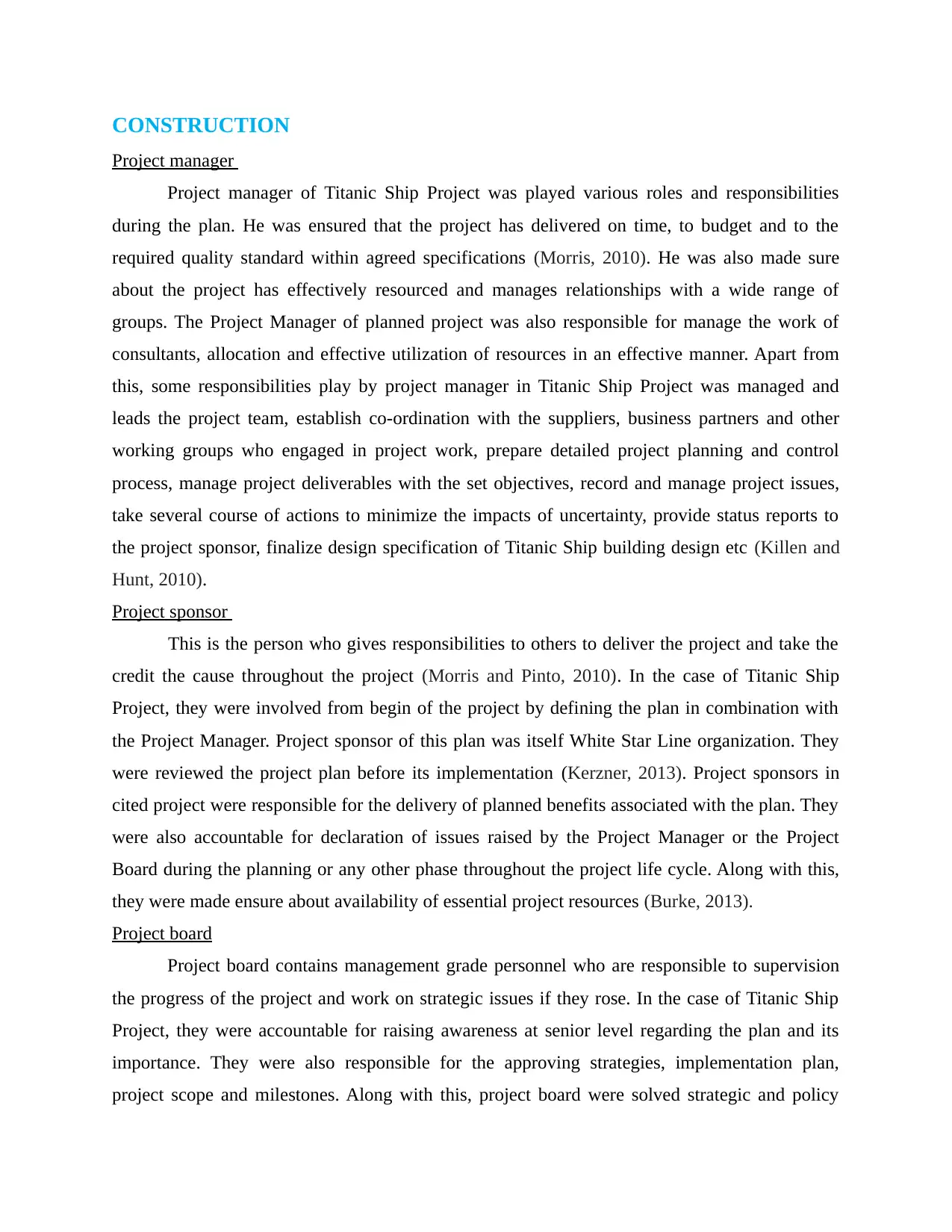
CONSTRUCTION
Project manager
Project manager of Titanic Ship Project was played various roles and responsibilities
during the plan. He was ensured that the project has delivered on time, to budget and to the
required quality standard within agreed specifications (Morris, 2010). He was also made sure
about the project has effectively resourced and manages relationships with a wide range of
groups. The Project Manager of planned project was also responsible for manage the work of
consultants, allocation and effective utilization of resources in an effective manner. Apart from
this, some responsibilities play by project manager in Titanic Ship Project was managed and
leads the project team, establish co-ordination with the suppliers, business partners and other
working groups who engaged in project work, prepare detailed project planning and control
process, manage project deliverables with the set objectives, record and manage project issues,
take several course of actions to minimize the impacts of uncertainty, provide status reports to
the project sponsor, finalize design specification of Titanic Ship building design etc (Killen and
Hunt, 2010).
Project sponsor
This is the person who gives responsibilities to others to deliver the project and take the
credit the cause throughout the project (Morris and Pinto, 2010). In the case of Titanic Ship
Project, they were involved from begin of the project by defining the plan in combination with
the Project Manager. Project sponsor of this plan was itself White Star Line organization. They
were reviewed the project plan before its implementation (Kerzner, 2013). Project sponsors in
cited project were responsible for the delivery of planned benefits associated with the plan. They
were also accountable for declaration of issues raised by the Project Manager or the Project
Board during the planning or any other phase throughout the project life cycle. Along with this,
they were made ensure about availability of essential project resources (Burke, 2013).
Project board
Project board contains management grade personnel who are responsible to supervision
the progress of the project and work on strategic issues if they rose. In the case of Titanic Ship
Project, they were accountable for raising awareness at senior level regarding the plan and its
importance. They were also responsible for the approving strategies, implementation plan,
project scope and milestones. Along with this, project board were solved strategic and policy
Project manager
Project manager of Titanic Ship Project was played various roles and responsibilities
during the plan. He was ensured that the project has delivered on time, to budget and to the
required quality standard within agreed specifications (Morris, 2010). He was also made sure
about the project has effectively resourced and manages relationships with a wide range of
groups. The Project Manager of planned project was also responsible for manage the work of
consultants, allocation and effective utilization of resources in an effective manner. Apart from
this, some responsibilities play by project manager in Titanic Ship Project was managed and
leads the project team, establish co-ordination with the suppliers, business partners and other
working groups who engaged in project work, prepare detailed project planning and control
process, manage project deliverables with the set objectives, record and manage project issues,
take several course of actions to minimize the impacts of uncertainty, provide status reports to
the project sponsor, finalize design specification of Titanic Ship building design etc (Killen and
Hunt, 2010).
Project sponsor
This is the person who gives responsibilities to others to deliver the project and take the
credit the cause throughout the project (Morris and Pinto, 2010). In the case of Titanic Ship
Project, they were involved from begin of the project by defining the plan in combination with
the Project Manager. Project sponsor of this plan was itself White Star Line organization. They
were reviewed the project plan before its implementation (Kerzner, 2013). Project sponsors in
cited project were responsible for the delivery of planned benefits associated with the plan. They
were also accountable for declaration of issues raised by the Project Manager or the Project
Board during the planning or any other phase throughout the project life cycle. Along with this,
they were made ensure about availability of essential project resources (Burke, 2013).
Project board
Project board contains management grade personnel who are responsible to supervision
the progress of the project and work on strategic issues if they rose. In the case of Titanic Ship
Project, they were accountable for raising awareness at senior level regarding the plan and its
importance. They were also responsible for the approving strategies, implementation plan,
project scope and milestones. Along with this, project board were solved strategic and policy
⊘ This is a preview!⊘
Do you want full access?
Subscribe today to unlock all pages.

Trusted by 1+ million students worldwide
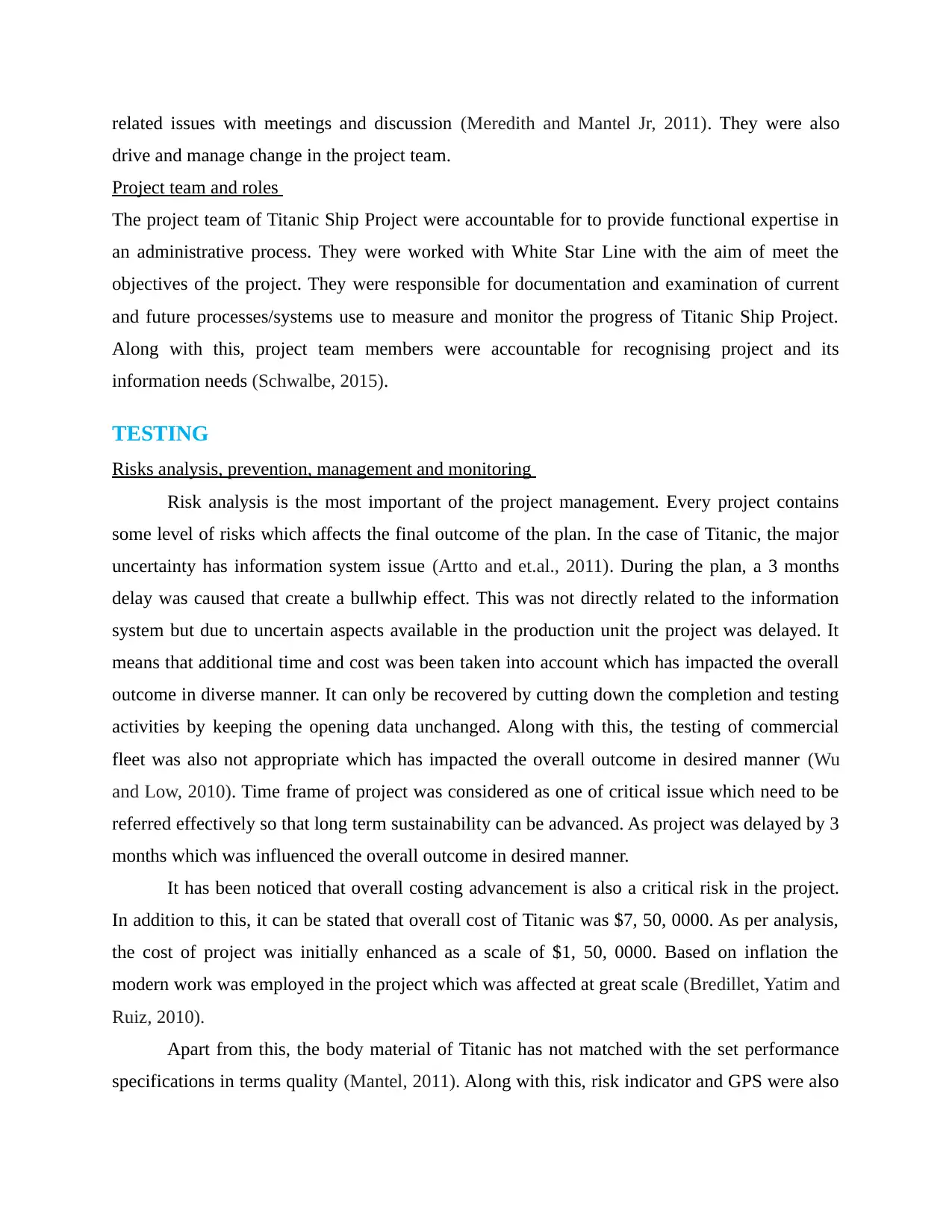
related issues with meetings and discussion (Meredith and Mantel Jr, 2011). They were also
drive and manage change in the project team.
Project team and roles
The project team of Titanic Ship Project were accountable for to provide functional expertise in
an administrative process. They were worked with White Star Line with the aim of meet the
objectives of the project. They were responsible for documentation and examination of current
and future processes/systems use to measure and monitor the progress of Titanic Ship Project.
Along with this, project team members were accountable for recognising project and its
information needs (Schwalbe, 2015).
TESTING
Risks analysis, prevention, management and monitoring
Risk analysis is the most important of the project management. Every project contains
some level of risks which affects the final outcome of the plan. In the case of Titanic, the major
uncertainty has information system issue (Artto and et.al., 2011). During the plan, a 3 months
delay was caused that create a bullwhip effect. This was not directly related to the information
system but due to uncertain aspects available in the production unit the project was delayed. It
means that additional time and cost was been taken into account which has impacted the overall
outcome in diverse manner. It can only be recovered by cutting down the completion and testing
activities by keeping the opening data unchanged. Along with this, the testing of commercial
fleet was also not appropriate which has impacted the overall outcome in desired manner (Wu
and Low, 2010). Time frame of project was considered as one of critical issue which need to be
referred effectively so that long term sustainability can be advanced. As project was delayed by 3
months which was influenced the overall outcome in desired manner.
It has been noticed that overall costing advancement is also a critical risk in the project.
In addition to this, it can be stated that overall cost of Titanic was $7, 50, 0000. As per analysis,
the cost of project was initially enhanced as a scale of $1, 50, 0000. Based on inflation the
modern work was employed in the project which was affected at great scale (Bredillet, Yatim and
Ruiz, 2010).
Apart from this, the body material of Titanic has not matched with the set performance
specifications in terms quality (Mantel, 2011). Along with this, risk indicator and GPS were also
drive and manage change in the project team.
Project team and roles
The project team of Titanic Ship Project were accountable for to provide functional expertise in
an administrative process. They were worked with White Star Line with the aim of meet the
objectives of the project. They were responsible for documentation and examination of current
and future processes/systems use to measure and monitor the progress of Titanic Ship Project.
Along with this, project team members were accountable for recognising project and its
information needs (Schwalbe, 2015).
TESTING
Risks analysis, prevention, management and monitoring
Risk analysis is the most important of the project management. Every project contains
some level of risks which affects the final outcome of the plan. In the case of Titanic, the major
uncertainty has information system issue (Artto and et.al., 2011). During the plan, a 3 months
delay was caused that create a bullwhip effect. This was not directly related to the information
system but due to uncertain aspects available in the production unit the project was delayed. It
means that additional time and cost was been taken into account which has impacted the overall
outcome in diverse manner. It can only be recovered by cutting down the completion and testing
activities by keeping the opening data unchanged. Along with this, the testing of commercial
fleet was also not appropriate which has impacted the overall outcome in desired manner (Wu
and Low, 2010). Time frame of project was considered as one of critical issue which need to be
referred effectively so that long term sustainability can be advanced. As project was delayed by 3
months which was influenced the overall outcome in desired manner.
It has been noticed that overall costing advancement is also a critical risk in the project.
In addition to this, it can be stated that overall cost of Titanic was $7, 50, 0000. As per analysis,
the cost of project was initially enhanced as a scale of $1, 50, 0000. Based on inflation the
modern work was employed in the project which was affected at great scale (Bredillet, Yatim and
Ruiz, 2010).
Apart from this, the body material of Titanic has not matched with the set performance
specifications in terms quality (Mantel, 2011). Along with this, risk indicator and GPS were also
Paraphrase This Document
Need a fresh take? Get an instant paraphrase of this document with our AI Paraphraser
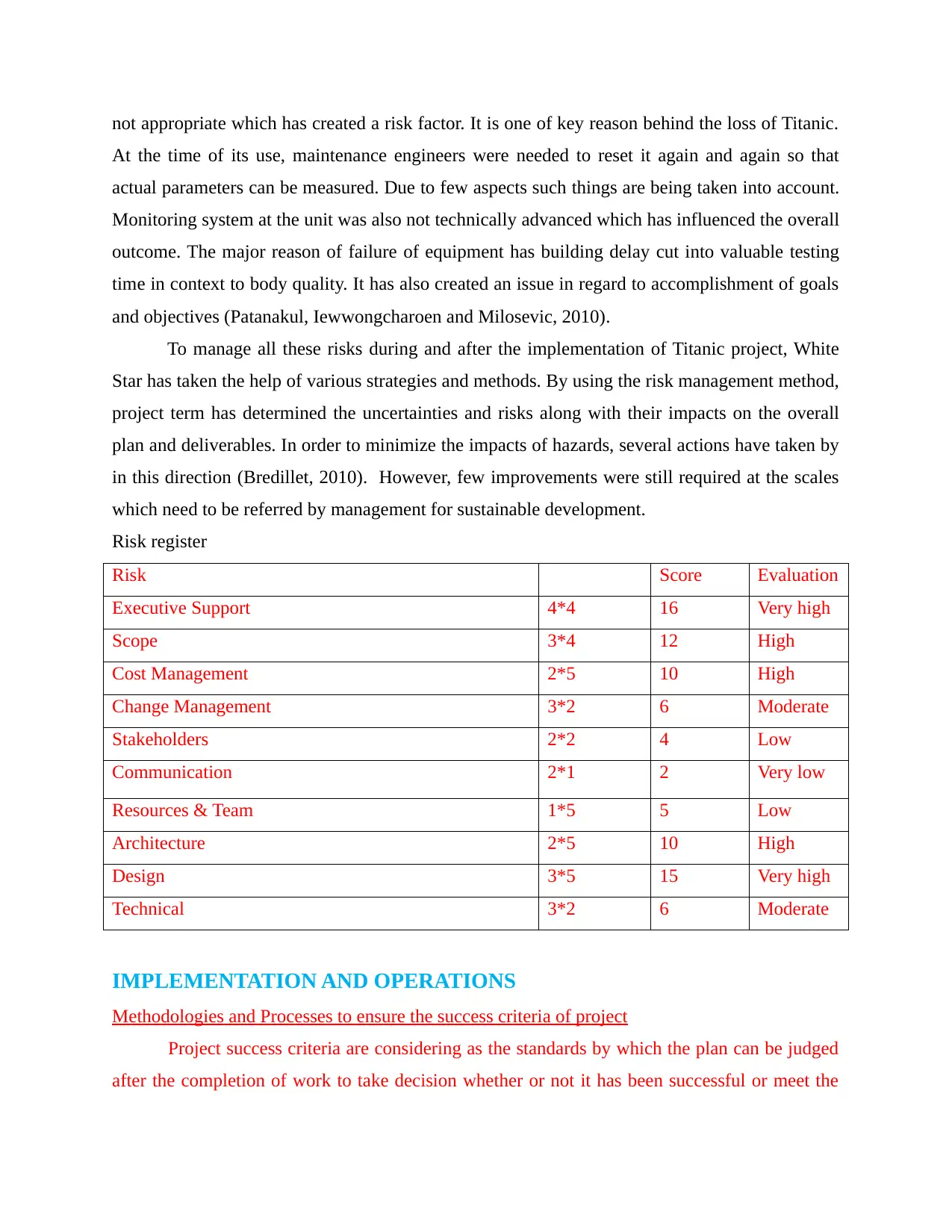
not appropriate which has created a risk factor. It is one of key reason behind the loss of Titanic.
At the time of its use, maintenance engineers were needed to reset it again and again so that
actual parameters can be measured. Due to few aspects such things are being taken into account.
Monitoring system at the unit was also not technically advanced which has influenced the overall
outcome. The major reason of failure of equipment has building delay cut into valuable testing
time in context to body quality. It has also created an issue in regard to accomplishment of goals
and objectives (Patanakul, Iewwongcharoen and Milosevic, 2010).
To manage all these risks during and after the implementation of Titanic project, White
Star has taken the help of various strategies and methods. By using the risk management method,
project term has determined the uncertainties and risks along with their impacts on the overall
plan and deliverables. In order to minimize the impacts of hazards, several actions have taken by
in this direction (Bredillet, 2010). However, few improvements were still required at the scales
which need to be referred by management for sustainable development.
Risk register
Risk Score Evaluation
Executive Support 4*4 16 Very high
Scope 3*4 12 High
Cost Management 2*5 10 High
Change Management 3*2 6 Moderate
Stakeholders 2*2 4 Low
Communication 2*1 2 Very low
Resources & Team 1*5 5 Low
Architecture 2*5 10 High
Design 3*5 15 Very high
Technical 3*2 6 Moderate
IMPLEMENTATION AND OPERATIONS
Methodologies and Processes to ensure the success criteria of project
Project success criteria are considering as the standards by which the plan can be judged
after the completion of work to take decision whether or not it has been successful or meet the
At the time of its use, maintenance engineers were needed to reset it again and again so that
actual parameters can be measured. Due to few aspects such things are being taken into account.
Monitoring system at the unit was also not technically advanced which has influenced the overall
outcome. The major reason of failure of equipment has building delay cut into valuable testing
time in context to body quality. It has also created an issue in regard to accomplishment of goals
and objectives (Patanakul, Iewwongcharoen and Milosevic, 2010).
To manage all these risks during and after the implementation of Titanic project, White
Star has taken the help of various strategies and methods. By using the risk management method,
project term has determined the uncertainties and risks along with their impacts on the overall
plan and deliverables. In order to minimize the impacts of hazards, several actions have taken by
in this direction (Bredillet, 2010). However, few improvements were still required at the scales
which need to be referred by management for sustainable development.
Risk register
Risk Score Evaluation
Executive Support 4*4 16 Very high
Scope 3*4 12 High
Cost Management 2*5 10 High
Change Management 3*2 6 Moderate
Stakeholders 2*2 4 Low
Communication 2*1 2 Very low
Resources & Team 1*5 5 Low
Architecture 2*5 10 High
Design 3*5 15 Very high
Technical 3*2 6 Moderate
IMPLEMENTATION AND OPERATIONS
Methodologies and Processes to ensure the success criteria of project
Project success criteria are considering as the standards by which the plan can be judged
after the completion of work to take decision whether or not it has been successful or meet the
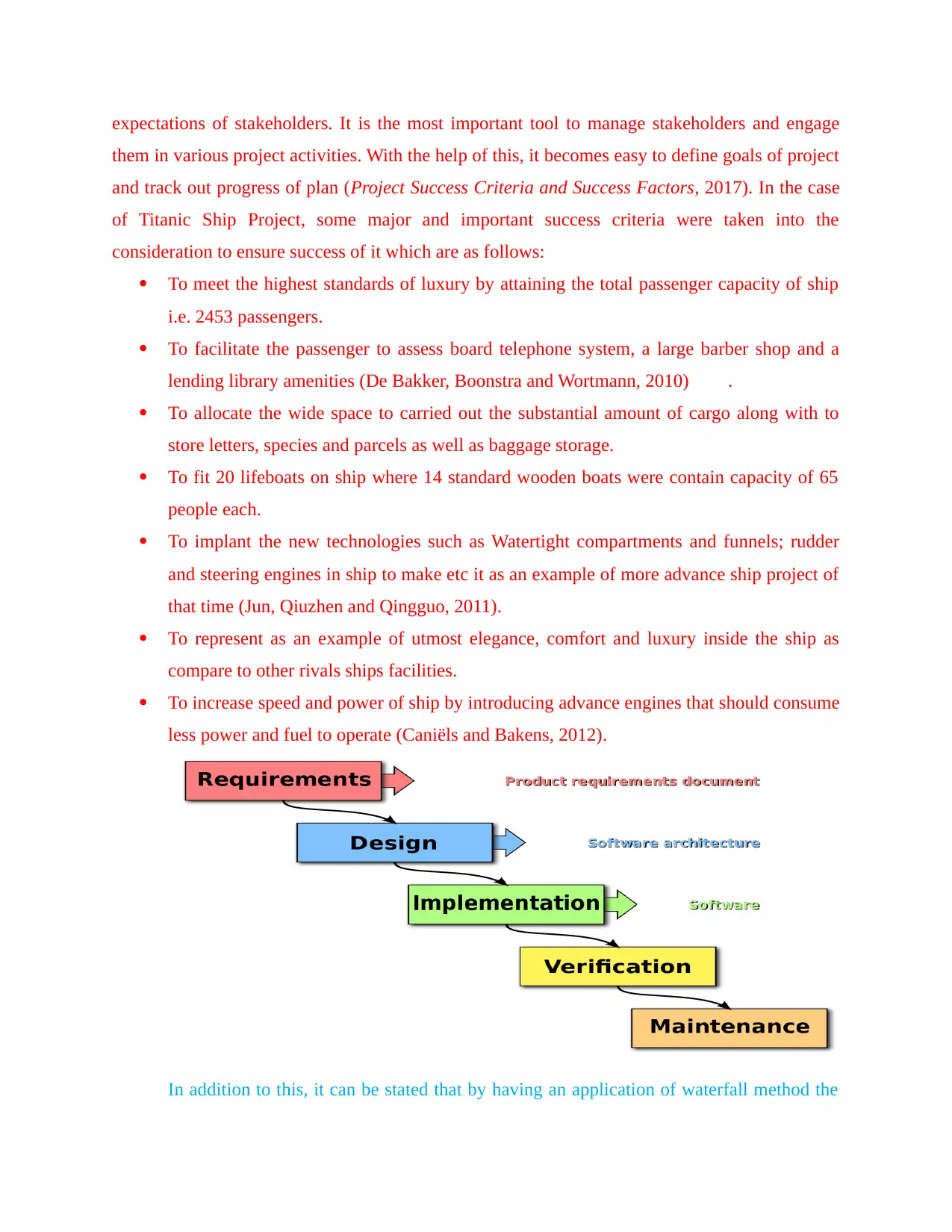
expectations of stakeholders. It is the most important tool to manage stakeholders and engage
them in various project activities. With the help of this, it becomes easy to define goals of project
and track out progress of plan (Project Success Criteria and Success Factors, 2017). In the case
of Titanic Ship Project, some major and important success criteria were taken into the
consideration to ensure success of it which are as follows:
To meet the highest standards of luxury by attaining the total passenger capacity of ship
i.e. 2453 passengers.
To facilitate the passenger to assess board telephone system, a large barber shop and a
lending library amenities (De Bakker, Boonstra and Wortmann, 2010) .
To allocate the wide space to carried out the substantial amount of cargo along with to
store letters, species and parcels as well as baggage storage.
To fit 20 lifeboats on ship where 14 standard wooden boats were contain capacity of 65
people each.
To implant the new technologies such as Watertight compartments and funnels; rudder
and steering engines in ship to make etc it as an example of more advance ship project of
that time (Jun, Qiuzhen and Qingguo, 2011).
To represent as an example of utmost elegance, comfort and luxury inside the ship as
compare to other rivals ships facilities.
To increase speed and power of ship by introducing advance engines that should consume
less power and fuel to operate (Caniëls and Bakens, 2012).
In addition to this, it can be stated that by having an application of waterfall method the
them in various project activities. With the help of this, it becomes easy to define goals of project
and track out progress of plan (Project Success Criteria and Success Factors, 2017). In the case
of Titanic Ship Project, some major and important success criteria were taken into the
consideration to ensure success of it which are as follows:
To meet the highest standards of luxury by attaining the total passenger capacity of ship
i.e. 2453 passengers.
To facilitate the passenger to assess board telephone system, a large barber shop and a
lending library amenities (De Bakker, Boonstra and Wortmann, 2010) .
To allocate the wide space to carried out the substantial amount of cargo along with to
store letters, species and parcels as well as baggage storage.
To fit 20 lifeboats on ship where 14 standard wooden boats were contain capacity of 65
people each.
To implant the new technologies such as Watertight compartments and funnels; rudder
and steering engines in ship to make etc it as an example of more advance ship project of
that time (Jun, Qiuzhen and Qingguo, 2011).
To represent as an example of utmost elegance, comfort and luxury inside the ship as
compare to other rivals ships facilities.
To increase speed and power of ship by introducing advance engines that should consume
less power and fuel to operate (Caniëls and Bakens, 2012).
In addition to this, it can be stated that by having an application of waterfall method the
⊘ This is a preview!⊘
Do you want full access?
Subscribe today to unlock all pages.

Trusted by 1+ million students worldwide
1 out of 17
Your All-in-One AI-Powered Toolkit for Academic Success.
+13062052269
info@desklib.com
Available 24*7 on WhatsApp / Email
![[object Object]](/_next/static/media/star-bottom.7253800d.svg)
Unlock your academic potential
Copyright © 2020–2025 A2Z Services. All Rights Reserved. Developed and managed by ZUCOL.
